Color and Appetite Matters!
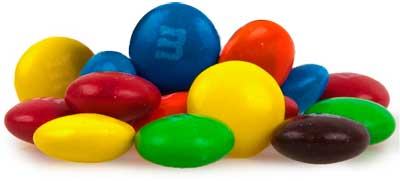
Blue color Facts
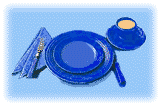
Of all the colors in the spectrum, blue is an appetite
suppressant. Weight loss plans suggest putting your food on a blue plate. Or
even better than that, put a blue light in your refrigerator and watch your
munchies disappear. Or here's another tip: Dye your food blue! A little black
will make it a double whammy.
Examples:
Does this make you hungry?
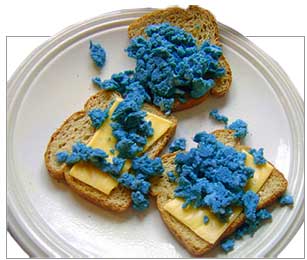
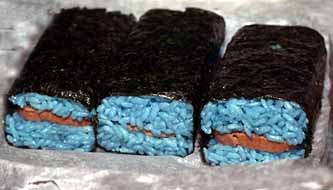
This is a delicacy prepared for the annual food party held
at the end of the author's color course at the University of Hawaii. It's a
"musubi" - rice in a seaweed
(nori) wrapper. It's of Japanese origin and is very popular in Hawaii in it's
natural state. In case you're wondering what the pink stuff is, it's spam. If
you want to create your own dyed food, use only natural "food
coloring" purchased in a grocery store. Other coloring agents are toxic.
Dramatic results can also be achieved by using a blue light
bulb for your dining area.
Why is blue an unappetizing color?
Blue food is a rare occurrence in nature. There are no leafy
blue vegetables (blue lettuce?), no blue meats (blueburger, well-done please),
and aside from blueberries and a few blue-purple potatoes from remote spots on
the globe, blue just doesn't exist in any significant quantity as a natural
food color.
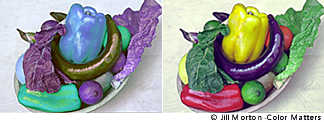
Consequently, we don't have an automatic appetite response
to blue. Furthermore, our primal nature avoids food that are poisonous. A
million years ago, when our earliest ancestors were foraging for food, blue,
purple and black were "color warning signs" of potentially lethal
food.
------------------------------------------------------
You are thirsty, not hungry!

Water Curbs Appetite
Drinking of water makes you understand the difference between being hungry and getting dehydrated and thus curbs in appetite of those things that can increase weight.
Water stops hunger by filling your stomach with a zero-calorie liquid. That will send signals to the brain that you're no longer hungry.
Drink a big glass of water to determine if you're really hungry. Make the water cold, rather than warm. Cold water will cause your metabolism to speed up to bring the water to body temperature, burning calories. For more dieting help, guzzle water before your meals. In a 2010 clinical trial reported by website Science Daily, dieters who drank two cups of water before meals lost five more pounds over 12 weeks than dieters who didn't increase their water intake.
------------------------------------------------------
Scientists investigated how food intake is regulated by the brain's "pleasure centres" which are known to be linked to addiction. Functional magnetic resonance imaging (fMRI) was used to observe the brain activity of overweight and obese volunteers for four hours after a meal. This crucial period has been shown to influence behaviour the next time a meal is eaten. Twelve men were given test meals designed as milk shakes that tasted the same and were matched for calories. One milk shake contained rapidly digested high-glycaemic index (GI) carbohydrates, often found in junk food, while the other was made with low GI carbohydrates.
You are thirsty, not hungry!

Water Curbs Appetite
Drinking of water makes you understand the difference between being hungry and getting dehydrated and thus curbs in appetite of those things that can increase weight.
Water stops hunger by filling your stomach with a zero-calorie liquid. That will send signals to the brain that you're no longer hungry.
Drink a big glass of water to determine if you're really hungry. Make the water cold, rather than warm. Cold water will cause your metabolism to speed up to bring the water to body temperature, burning calories. For more dieting help, guzzle water before your meals. In a 2010 clinical trial reported by website Science Daily, dieters who drank two cups of water before meals lost five more pounds over 12 weeks than dieters who didn't increase their water intake.
------------------------------------------------------
Junk food as addictive as drugs!
Junk food really could be addictive and stimulate cravings in much the same way as an illicit drug, a brain scanning study has shown. The findings suggest that limiting "high-glycaemic" carbohydrates that cause blood sugar to surge could help curb over-eating and obesity.
Scientists investigated how food intake is regulated by the brain's "pleasure centres" which are known to be linked to addiction. Functional magnetic resonance imaging (fMRI) was used to observe the brain activity of overweight and obese volunteers for four hours after a meal. This crucial period has been shown to influence behaviour the next time a meal is eaten. Twelve men were given test meals designed as milk shakes that tasted the same and were matched for calories. One milk shake contained rapidly digested high-glycaemic index (GI) carbohydrates, often found in junk food, while the other was made with low GI carbohydrates.
Consumption of the high GI drink was followed by an initial surge in blood sugar levels followed by a sharp crash four hours later. The sudden decrease in blood sugar was associated with excessive hunger and intense activation of the nucleus accumbens, a brain region central to addictive behaviour.
Lead scientist Dr David Ludwig, director of the New Balance Foundation Obesity Prevention Centre in Boston, US, said: "Beyond reward and craving, this part of the brain is also linked to substance abuse and dependence, which raises the question as to whether certain foods might be addictive.
"These findings suggest that limiting high-glycaemic index carbohydrates like white bread and potatoes could help obese individuals reduce cravings and control the urge to over-eat."
------------------------------------------------------
There is natural appetite suppressants !
APPLES
All fruit and vegetables are high satiety (or filling) foods that contain a lot of water, air and fibre to produce ‘full-up’ signals in the small intestine — but research has shown apples are particularly effective for weight watchers. Once digested, they produce the hormone GLP-1, which sends signals to the brain to persuade you into thinking you are full up. One study showed people ate 15 per cent fewer calories after having an apple before a main meal. Apparently, the trick is to eat high-satiety foods at the beginning of a meal so you feel fuller early on and don’t compensate later by eating more. TIP: Eat one medium-sized apple 15 minutes before meals to help regulate your appetite.
RED PEPPERS
Feeling the burn could be the best way to get bikini ready, but it doesn’t have to mean hours sweating in the gym. Recent research found that sprinkling just half a teaspoon of chopped-up red chilli peppers on meals can curb your appetite. Scientists discovered Capsaicin — the element responsible for giving chilli peppers their heat — reduces hunger pangs, while increasing energy levels. You won’t get the same effect just by taking a supplement, claim the researchers from Purdue University, Indiana — you have to taste the pepper.
And, if you normally avoid spicy food — even better. Those who did not regularly eat chilli experienced an even greater decrease of hunger, especially for fatty, salty and sweet foods.
TIP: Most dried and fresh chillies contain capsaicin. Sprinkle half a teaspoonful over main meals.
SEAWEED
Starting your day with a seaweed shake could be the secret to keeping slim. Dutch scientists have found that adding algae, a natural dietary fibre derived from seaweed, to a drink, suppressed hunger pangs by 30 per cent and kept dieters feeling full until lunchtime.
"These findings suggest that limiting high-glycaemic index carbohydrates like white bread and potatoes could help obese individuals reduce cravings and control the urge to over-eat."
------------------------------------------------------
There is natural appetite suppressants !
APPLES
All fruit and vegetables are high satiety (or filling) foods that contain a lot of water, air and fibre to produce ‘full-up’ signals in the small intestine — but research has shown apples are particularly effective for weight watchers. Once digested, they produce the hormone GLP-1, which sends signals to the brain to persuade you into thinking you are full up. One study showed people ate 15 per cent fewer calories after having an apple before a main meal. Apparently, the trick is to eat high-satiety foods at the beginning of a meal so you feel fuller early on and don’t compensate later by eating more. TIP: Eat one medium-sized apple 15 minutes before meals to help regulate your appetite.
RED PEPPERS
Feeling the burn could be the best way to get bikini ready, but it doesn’t have to mean hours sweating in the gym. Recent research found that sprinkling just half a teaspoon of chopped-up red chilli peppers on meals can curb your appetite. Scientists discovered Capsaicin — the element responsible for giving chilli peppers their heat — reduces hunger pangs, while increasing energy levels. You won’t get the same effect just by taking a supplement, claim the researchers from Purdue University, Indiana — you have to taste the pepper.
And, if you normally avoid spicy food — even better. Those who did not regularly eat chilli experienced an even greater decrease of hunger, especially for fatty, salty and sweet foods.
TIP: Most dried and fresh chillies contain capsaicin. Sprinkle half a teaspoonful over main meals.
SEAWEED
Starting your day with a seaweed shake could be the secret to keeping slim. Dutch scientists have found that adding algae, a natural dietary fibre derived from seaweed, to a drink, suppressed hunger pangs by 30 per cent and kept dieters feeling full until lunchtime.
Researchers studied the algae in liquid form and found that, upon reaching the stomach, it becomes a gel, slowing down the emptying of food and mimicking the effect of eating solids.
The American Dietetic Association agreed that it may stop people feeling hungry between meals.
The American Dietetic Association agreed that it may stop people feeling hungry between meals.
TIP: The algae-based meal replacement drink is still in development, but algae supplements are available from good health food shops such as Holland and Barrett
GREEN TEA
Green tea contains catechins, a substance thought to stimulate the body to burn more calories, helping you to beat the bulge in double-quick time.
Drinking three to six cups of green tea a day speeds up the rate your body burns cellular energy by up to 40 per cent, and also increases the rate of fat burning.
Researchers found this effect is caused by the combination of caffeine and flavonoids found in the tea, whether it is drunk hot or cold. Green tea also contains certain antioxidants which are believed to have an effect on the hormone Leptin — responsible for controlling appetite.
TIP: Substitute other hot drinks for green tea, and consume regularly throughout the day for a figure-fixing beverage.
EGGS
The quality of egg protein is the highest of any whole food product — second only to human breast milk — and according to a recent scientific review, this high protein content plays a role in weight management.
According to a report in the Journal Of the American College of Nutrition, eating two scrambled eggs for breakfast resulted in people eating fewer calories for the rest of the day — and, particularly, the next 36 hours. TIP: Kick start the day with an egg to stave off hunger pangs until lunch.
LEMONS
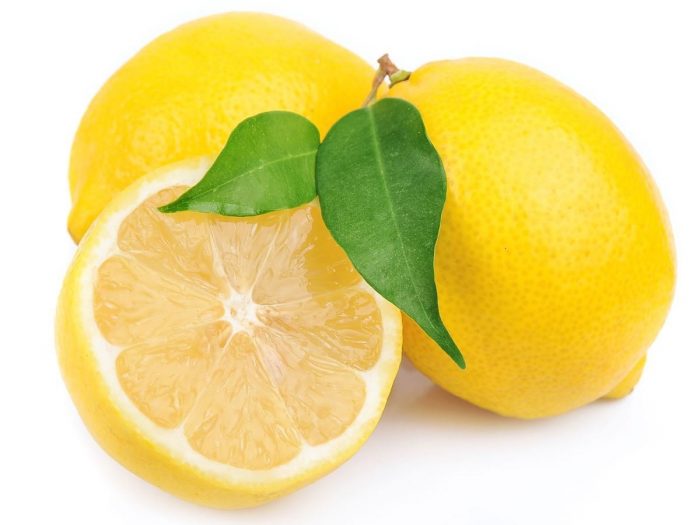
Lemons contain pectin, a natural soluble fibre and gelling agent, which mops up fat stored by the body, and slows the digestive process so you feel full after eating less food. Researchers found that lemon acids and pectin can slow the absorption of sugar after a meal, and avoid those low blood-sugar dips which can result in snacking.
GREEN TEA
Green tea contains catechins, a substance thought to stimulate the body to burn more calories, helping you to beat the bulge in double-quick time.
Drinking three to six cups of green tea a day speeds up the rate your body burns cellular energy by up to 40 per cent, and also increases the rate of fat burning.
Researchers found this effect is caused by the combination of caffeine and flavonoids found in the tea, whether it is drunk hot or cold. Green tea also contains certain antioxidants which are believed to have an effect on the hormone Leptin — responsible for controlling appetite.
TIP: Substitute other hot drinks for green tea, and consume regularly throughout the day for a figure-fixing beverage.
EGGS
The quality of egg protein is the highest of any whole food product — second only to human breast milk — and according to a recent scientific review, this high protein content plays a role in weight management.
According to a report in the Journal Of the American College of Nutrition, eating two scrambled eggs for breakfast resulted in people eating fewer calories for the rest of the day — and, particularly, the next 36 hours. TIP: Kick start the day with an egg to stave off hunger pangs until lunch.
LEMONS

Lemons contain pectin, a natural soluble fibre and gelling agent, which mops up fat stored by the body, and slows the digestive process so you feel full after eating less food. Researchers found that lemon acids and pectin can slow the absorption of sugar after a meal, and avoid those low blood-sugar dips which can result in snacking.
Vitamin C in lemons also helps us to produce carnitine — an amino acid to encourage the body to burn fat. Studies at Arizona State University found that volunteers with adequate vitamin C burned 30 per cent more fat during exercise than those with low levels. TIP: Try to incorporate the zest and juice of a lemon in your diet daily, squeeze over salads, into sauces or simply add to warm water and drink.
WATER
We all know that drinking water before meals makes us feel fuller, but just how useful is it as a natural appetite suppressant?. A study published in 2010 concluded that drinking water just before meals can actually help people to lose weight. Researchers split 48 overweight adults aged 55 to 75 into two groups.
The first group was asked to eat a low-calorie diet but not to drink any extra water before meals. The second group was asked to eat the same diet but also to drink two glasses of water (500 ml) just before each meal. After 12 weeks, members of the water drinking group had lost, on average, about 2kg more than the non-water drinking group — simply because they felt fuller during each meal and as a result ate less.
TIP: Drink a large glass of water prior to meals. Remember drinking excessive amounts can be dangerous, so be careful not to exceed the extra 500 ml recommended.
GARLIC
Researchers in Israel recently discovered that not only can the humble garlic bulb prevent weight gain; it might also cause weight loss.
The key to garlic’s health-giving properties is a compound called allicin, also responsible for giving it that pungent smell. But the trial found the strong odour of garlic stimulates the satiety centre in the brain, reducing feelings of hunger. It also stimulates the nervous system to release hormones such as adrenalin, which in turn speed up your metabolic rate so you burn more calories.
TIP: Add garlic routinely to all savoury dishes when cooking. Powdered supplements are also effective and help avoid garlic breath!
SLEEP
If you want to stay slim, get an early night. As you will have read above, leptin and another hormone, ghrelin, are both known to directly influence our appetite — when leptin falls, we crave crbohydrates, when ghrelin levels increase our appetite is stimulated. Scientists discovered those who slept less than eight hours a night not only had lower levels of leptin, and increased amounts of ghrelin, but also had higher levels of body fat.
So in a nutshell, those who slept the least, weighed the most.
TIP: Get at least eight hours’ sleep a night to prevent over-eating.
CINNAMON
A Scandinavian study published in the American Journal of Clinical Nutrition found that when volunteers were given rice pudding with three grams of cinnamon, they produced less insulin after the meal.
Because insulin is the hormone that turns excess sugar into fat, this means less weight gain. As well as lowering blood sugar levels cinnamon may slow down the emptying of the stomach, meaning it can make you feel fuller for longer.
TIP: Sprinkle a teaspoon of cinnamon daily over cereals, yoghurt or fruit, use to season puddings or even stir into coffee. It is especially effective if consumed directly after meals.
------------------------------------------------------
Is Glycemic Index important for your diet?
The glycemic index is a tool you can use as part of your overall weight-control and healthy-eating strategies. Why? Because the glycemic index goes beyond calories; it encourages you to look at the way foods are digested and metabolized in your body and what impact that has on your body weight and how full you feel after eating.
WATER
The first group was asked to eat a low-calorie diet but not to drink any extra water before meals. The second group was asked to eat the same diet but also to drink two glasses of water (500 ml) just before each meal. After 12 weeks, members of the water drinking group had lost, on average, about 2kg more than the non-water drinking group — simply because they felt fuller during each meal and as a result ate less.
TIP: Drink a large glass of water prior to meals. Remember drinking excessive amounts can be dangerous, so be careful not to exceed the extra 500 ml recommended.
GARLIC
Researchers in Israel recently discovered that not only can the humble garlic bulb prevent weight gain; it might also cause weight loss.
The key to garlic’s health-giving properties is a compound called allicin, also responsible for giving it that pungent smell. But the trial found the strong odour of garlic stimulates the satiety centre in the brain, reducing feelings of hunger. It also stimulates the nervous system to release hormones such as adrenalin, which in turn speed up your metabolic rate so you burn more calories.
TIP: Add garlic routinely to all savoury dishes when cooking. Powdered supplements are also effective and help avoid garlic breath!
SLEEP
If you want to stay slim, get an early night. As you will have read above, leptin and another hormone, ghrelin, are both known to directly influence our appetite — when leptin falls, we crave crbohydrates, when ghrelin levels increase our appetite is stimulated. Scientists discovered those who slept less than eight hours a night not only had lower levels of leptin, and increased amounts of ghrelin, but also had higher levels of body fat.
So in a nutshell, those who slept the least, weighed the most.
TIP: Get at least eight hours’ sleep a night to prevent over-eating.
CINNAMON
A Scandinavian study published in the American Journal of Clinical Nutrition found that when volunteers were given rice pudding with three grams of cinnamon, they produced less insulin after the meal.
Because insulin is the hormone that turns excess sugar into fat, this means less weight gain. As well as lowering blood sugar levels cinnamon may slow down the emptying of the stomach, meaning it can make you feel fuller for longer.
TIP: Sprinkle a teaspoon of cinnamon daily over cereals, yoghurt or fruit, use to season puddings or even stir into coffee. It is especially effective if consumed directly after meals.
------------------------------------------------------
Is Glycemic Index important for your diet?
The glycemic index is a tool you can use as part of your overall weight-control and healthy-eating strategies. Why? Because the glycemic index goes beyond calories; it encourages you to look at the way foods are digested and metabolized in your body and what impact that has on your body weight and how full you feel after eating.
Your body performs best when your blood sugar is kept relatively constant. If your blood sugar drops too low, you become lethargic and/or experience increased hunger. And if it goes too high, your brain signals your pancreas to secrete more insulin. Insulin brings your blood sugar back down, but primarily by converting the excess sugar to stored fat. Also, the greater the rate of increase in your blood sugar, the more chance that your body will release an excess amount of insulin, and drive your blood sugar back down too low. Therefore, when you eat foods that cause a large and rapid glycemic response, you may feel an initial elevation in energy and mood as your blood sugar rises, but this is followed by a cycle of increased fat storage, lethargy, and more hunger!
The number listed next to each food is its glycemic index. This is a value obtained by monitoring a persons blood sugar after eating the food. The value can vary slightly from person to person and from one type or brand of food and another. A noticeable difference is the GI rating of Special-K which produced considerably different results in tests in the US and Australia, most likely resulting from different ingredients in each location. Despite this slight variation the index provide a good guide to which foods you should be eating and which foods to avoid.The glycemic index range is as follows:
Low GI = 55 or less (release energy slowly, you feel full longer, so you end up eating less)
Medium GI = 56 - 69
High GI = 70 or more (release energy quickly, feeling hungry sooner so you end up eating more)
|
Breakfast Cereal
Staples
| Bread
Snacks & Sweet Foods
Legumes (Beans)
| Vegetables
Fruits
Dairy
|
------------------------------------------------------
Constipation can make you gain weight?. Solve it now!
Most people, when reading about weight loss fads, will never hear about having regular bowel movements. It is something that people tend to shy away from writing about, yet it is vitally important.
It is important for a bowel movement to occur for every single meal that you eat. If you eat three meals a day you should have three bowel movements. If you are eating three meals a day and you do not have three bowel movements, where is the excess stored? Answer: It is stored in the colon, which becomes more and more impacted over time, causing the belly to bulge. We have seen very attractive people that look thin and they have a bowel movement only once a week! People have said, "Well they look good, so it cannot be all that bad." Unfortunately this attitude causes much more harm than one would think. The excess fecal matter is stored in the body and as it adds to the body weight of these individuals, muscle is lost. So, if a person is constipated, their body is filling up with fecal matter!
This leads to weight gain problems, because of poor nutrient absorption. When sludge begins to line the colon walls it becomes harder for nutrients to be absorbed into the body, as the body must now try and extract nutrients through this wall of fecal matter.
SOLUTIONS: Is food medicine? Sometimes, yes. It's becoming clear in recent years that what you eat can be highly effective in preventing or reversing some health problems, especially chronic constipation. Constipation is a symptom, not a disease. If you want safe and effective long-term relief for chronic constipation, you don't need to look any further than your grocer's shelves. Hundreds of foods and plant-based fiber products are available to relieve constipation -- naturally.
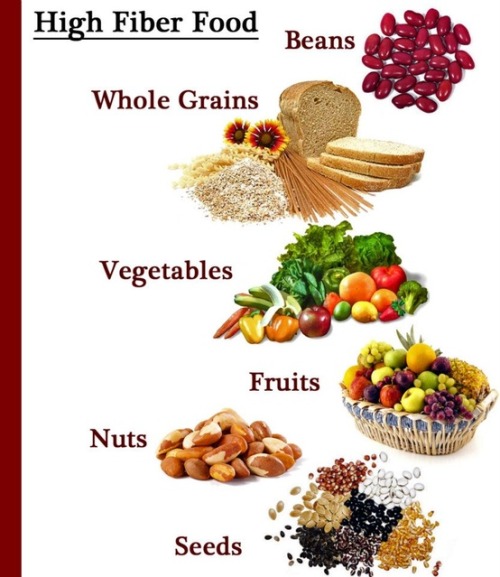
Dietary fiber refers to the edible parts of plants or carbohydrates that cannot be digested.
Fiber is in all plant foods, including fruits, vegetables, grains, nuts, seeds, and legumes.
You can also find a form of fiber called chitin in the shells of crustaceans such as crab, lobster, and shrimp.
How much fiber do we need daily?
Aren't prunes a natural laxative?
Often called "Nature's Remedy," prunes contain sorbitol, which has a natural, laxative effect in the body. Dried plums (yes, prunes!) are also high in disease-fighting antioxidants and have both insoluble and soluble fiber. One cup of pitted, uncooked prunes contains 12 grams of fiber. Three dried plums have 3.9 grams of fiber.
Prunes (1 raw, around 35 calories, Dietary Fibre: 1g)
One of the most common home remedies for constipation are dried prunes. They are are rich in fibre, vitamin A and potassium -- and also taste great in juice-form.
Pears (1 raw, 96 calories, Dietary Fibre: 5.1 g)
Pears are considered to be natural laxatives and can ease the movement of stoolthrough the intestines.
Broccoli (1 cup, 30 calories, Dietary Fibre: 2.3 g)
Most of us know that broccoli has an endless list of health benefits -- being a super source of fibre is just one of them.
Flaxseeds (30 g per serving (2 teaspoons) : 153 calories. Fibre: 8g. )
Flaxseeds (not in oil form) is another natural way to make you go. Flax is full of fibre and is rich in omega-3 fatty acids.
Carrots ( 1 raw,small (50 g) : 21 calories. Dietary Fibre: 1.4 g)
Carrots alone won't make you go to the bathroom right away. Full of fibre, raw carrots that are part of a healthy fibre-filled diet can improve your stool movement.Remember, eat them raw. Cooked carrots can lead to constipation.
Beans ( Dried beans, such as kidney, black and navy beans, lentils ).
Peaches (1 raw, 38 calories. Dietary Fibre: 1.5 g)
Eaten both dried or fresh, peaches are not only in season, but are also packed with fibre.
Pineapple (1 cup diced, 78 calories. Dietary Fibre: 2.2 g)
What causes constipation? Well, the obvious culprits include a low fiber diet, repeatedly ignoring the urge to go, not drinking enough water, or a lack of exercise.
But constipation also has other, less-well-known causes, including certain medications and supplements, as well as potentially serious medical conditions.
Which type of fiber is best to ease constipation?
Go for whole-grain breads, cereals, and pastas. Cereal fibers generally have cell walls that resist digestion and retain water within the cellular structures. Wheat bran can be highly effective as a natural laxative.
Go for whole-grain breads, cereals, and pastas. Cereal fibers generally have cell walls that resist digestion and retain water within the cellular structures. Wheat bran can be highly effective as a natural laxative.
How much fiber do we need daily?
Women should aim for 21 to 25 grams of fiber daily. Men should aim for 30 to 38 grams of fiber daily. Eat at least nine servings (2 cups) of fiber-filled fruits and vegetables each day, including apples, oranges, broccoli, berries, pears, peas, figs, carrots, and beans. Some people get stomach cramps and gas when they increase their intake of fiber. Change your diet gradually and increase fluids to reduce discomfort.
Aren't prunes a natural laxative?
Often called "Nature's Remedy," prunes contain sorbitol, which has a natural, laxative effect in the body. Dried plums (yes, prunes!) are also high in disease-fighting antioxidants and have both insoluble and soluble fiber. One cup of pitted, uncooked prunes contains 12 grams of fiber. Three dried plums have 3.9 grams of fiber.
LIST OF NATURAL LAXATIVES YOU SHOULD TRY AND IT´S CALORIES
One of the most common home remedies for constipation are dried prunes. They are are rich in fibre, vitamin A and potassium -- and also taste great in juice-form.
Pears (1 raw, 96 calories, Dietary Fibre: 5.1 g)
Pears are considered to be natural laxatives and can ease the movement of stoolthrough the intestines.
Broccoli (1 cup, 30 calories, Dietary Fibre: 2.3 g)
Most of us know that broccoli has an endless list of health benefits -- being a super source of fibre is just one of them.
Flaxseeds (30 g per serving (2 teaspoons) : 153 calories. Fibre: 8g. )
Flaxseeds (not in oil form) is another natural way to make you go. Flax is full of fibre and is rich in omega-3 fatty acids.
Carrots ( 1 raw,small (50 g) : 21 calories. Dietary Fibre: 1.4 g)
Carrots alone won't make you go to the bathroom right away. Full of fibre, raw carrots that are part of a healthy fibre-filled diet can improve your stool movement.Remember, eat them raw. Cooked carrots can lead to constipation.
Beans ( Dried beans, such as kidney, black and navy beans, lentils ).
Example: Canned Red Kidney Beans 400 g ( Half of a drained can (120g) contains (125kcal)
Peaches (1 raw, 38 calories. Dietary Fibre: 1.5 g)
Eaten both dried or fresh, peaches are not only in season, but are also packed with fibre.
Pineapple (1 cup diced, 78 calories. Dietary Fibre: 2.2 g)
It cures constipation and irregular bowel movement. Pineapple is rich in fiber, making it effective in curing constipation and irregular bowel movement.
Figs (1 medium, 37 calories. Dietary Fibre: 1.4 g)
Another great source of fibre, figs can make your stool softer for easier digestion.
Whole Grains (Whole grain bread (1 slice), 90 calories. Dietary Fibre: 5g. / Oats (30 g), 102 calories. Dietary Fibre: 4.8 g. / All Bran Cereal (50 g), 125 calories. Dietary Fibre: 16.6)
Opting for whole grain breads, oatmeal and bran cereal are easy ways to fill your body up with fibre.
Figs (1 medium, 37 calories. Dietary Fibre: 1.4 g)
Another great source of fibre, figs can make your stool softer for easier digestion.
Whole Grains (Whole grain bread (1 slice), 90 calories. Dietary Fibre: 5g. / Oats (30 g), 102 calories. Dietary Fibre: 4.8 g. / All Bran Cereal (50 g), 125 calories. Dietary Fibre: 16.6)
Opting for whole grain breads, oatmeal and bran cereal are easy ways to fill your body up with fibre.
LIST of FOODS TO AVOID THAT CAUSE CONSTIPATION
But constipation also has other, less-well-known causes, including certain medications and supplements, as well as potentially serious medical conditions.
There are many causes of constipation including medications, poor bowel habits, low fiber diets, abuse of laxatives, hormonal disorders, and diseases primarily of other parts of the body that also affect the colon.
The two disorders limited to the colon that cause constipation are colonic inertia and pelvic floor dysfunction.
High levels of estrogen and progesterone during pregnancy also can cause constipation.




No comments:
Post a Comment